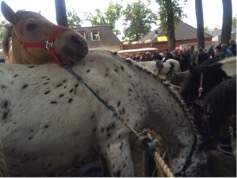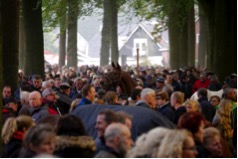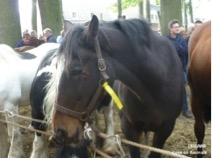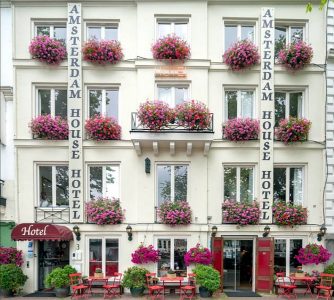Two teams from Eyes on Animals checked the horsemarket in Zuidlaren, the nightteam from Monday evening 11 pm until 11 am Tuesday morning. The horses have been relocated to one central place, in order to allow a better overview. All animals were standing on soft earth, which is quite an improvement. At midnight the animals arrived on the premises and were met by veterinarians who actively monitored the entrance. The market was fenced in by high gates so no horses could be snuck in. The unloading took place in an orderly manner: between midnight and 06.00 am only the drivers, traders who were registered, veterinarians and crewmembers were allowed on the premises, in addition to the Eyes on Animals team and two inspectors from NVWA who were present from the onset of the arrival of the horse trucks at midnight. To prevent horses slipping during unloading the organization had provided sand where animals were unloaded.
A compliment is due to Stens Transport, whose driver would not unload his horses on the street but took an effort to maneuver the truck so that the foals he had on board landed immediately on soft grass. The animals themselves were unloaded carefully: the driver who accompanied the first foal waited for four other animals to first come out of the truck and only started walking when all five animals were together in order to keep them calm. EonA told the driver how pleased we were.
This year most of the market was illuminated with soft green light. A double set of rope was tied to the posts so smaller animals could be secured safely. Taller horses did not benefit though because they could step over the ropes, which might endanger them.
This year there were more group-pens in which small ponies were housed. EonA is in favor of such paddocks, because it allows the animals to move about freely.
There was plenty of hay available and almost all horses started nibbling immediately. There were also enough water points and buckets, but very few owners made use off them. We only saw 15 water buckets in use.
This year there was no noise pollution because of the new location further away from the fair. Moreover there were noise barriers around the fairground. The organisation made an effort to improve the circumstances for the animals. We appreciate that tremendously.
However when the horse market opened to the public at 6 am did problems arose. The market is way too narrow for such a huge crowd of human visitors. During our inspection rounds we found that measures taken to increase animal welfare during the horsemarket have failed in quite a few ways during the daytime. At the export inspection everything went smoothly and calm though. No people were allowed in except for the ones who had a reason to be there, all animals had food and water. From the location they could be loaded into the trucks right away.
During the day the horse market area was far too crowded. People had to pass too close to the horses’ hindquarters and were in danger of being struck, which actually happened a few times. Horses were tethered very close to one another and could not lie down if they wished to do so. All horses were provided with hay but we hardly ever saw anyone give them water. Most traders just will not give water, even if you provide a hundred buckets.
We also saw horses with injuries that may have happened during transport and were not noticed or maybe they were injured while standing on the market. The posts they were tethered to were insufficient; a few horses got tangled up with their legs.
As usual many people were drunk and climbed on top of horses’ backs and played other pranks. The loading of the horses took place in a narrow street next to the premise, where all kinds of things went wrong: slipping horses, bucking horses, lots of screaming and swearing. People were curious and thus a crowd grew, which caused the animals even more stress. We concluded that, the aim of the organization was not fulfilled. In the daytime the market is still an unacceptable place for horses donkeys and ponies. A horse market just cannot combined with public entertainment and alcohol. As usual we will report our findings to all parties involved.
Finally, Eyes on Animals observed that on the Zuidlaren market, which by law is a “place of transfer”, the authorities still do not enforce the many provisions applicable for “long journeys” which are prescribed by the EU Transport Regulation 1/2005. This is very worrisome. Eyes on Animals will -again- bring up this serious issue at the Ministry of Economic Affairs, the NVWA authorities and the advisory council for animal affairs, the RDA.





